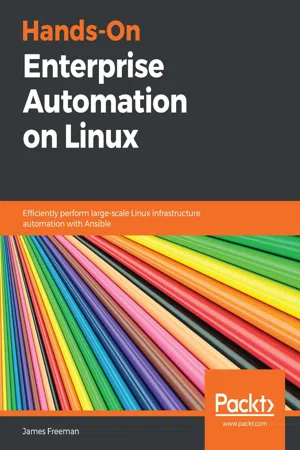
Hands-On Enterprise Automation on Linux
Efficiently perform large-scale Linux infrastructure automation with Ansible
- 512 pages
- English
- ePUB (mobile friendly)
- Available on iOS & Android
Hands-On Enterprise Automation on Linux
Efficiently perform large-scale Linux infrastructure automation with Ansible
About This Book
Achieve enterprise automation in your Linux environment with this comprehensive guide
Key Features
- Automate your Linux infrastructure with the help of practical use cases and real-world scenarios
- Learn to plan, build, manage, and customize OS releases in your environment
- Enhance the scalability and efficiency of your infrastructure with advanced Linux system administration concepts
Book Description
Automation is paramount if you want to run Linux in your enterprise effectively. It helps you minimize costs by reducing manual operations, ensuring compliance across data centers, and accelerating deployments for your cloud infrastructures.
Complete with detailed explanations, practical examples, and self-assessment questions, this book will teach you how to manage your Linux estate and leverage Ansible to achieve effective levels of automation. You'll learn important concepts on standard operating environments that lend themselves to automation, and then build on this knowledge by applying Ansible to achieve standardization throughout your Linux environments.
By the end of this Linux automation book, you'll be able to build, deploy, and manage an entire estate of Linux servers with higher reliability and lower overheads than ever before.
What you will learn
- Perform large-scale automation of Linux environments in an enterprise
- Overcome the common challenges and pitfalls of extensive automation
- Define the business processes needed to support a large-scale Linux environment
- Get well-versed with the most effective and reliable patch management strategies
- Automate a range of tasks from simple user account changes to complex security policy enforcement
- Learn best practices and procedures to make your Linux environment automatable
Who this book is for
This book is for anyone who has a Linux environment to design, implement, and maintain. Open source professionals including infrastructure architects and system administrators will find this book useful. You're expected to have experience in implementing and maintaining Linux servers along with knowledge of building, patching, and maintaining server infrastructure. Although not necessary, knowledge of Ansible or other automation technologies will be beneficial.
Frequently asked questions
Information
Section 1: Core Concepts
- Chapter 1, Building a Standard Operating Environment on Linux
- Chapter 2, Automating Your IT Infrastructure with Ansible
- Chapter 3, Streamlining Infrastructure Management with AWX
Building a Standard Operating Environment on Linux
- Understanding the challenges of Linux environment scaling
- What is an SOE?
- Exploring SOE benefits
- Knowing when to deviate from standards
- Ongoing maintenance of SOEs
Understanding the challenges of Linux environment scaling
Challenges of non-standard environments
Early growth of a non-standard environment
Impacts of non-standard environments
Scaling up non-standard environments
Addressing the challenges
- Realizing economies of scale
- Being efficient in day-to-day operations
- Making it easy for all involved to get up to speed quickly and easily
- Being aligned with the growing needs of the business
- Security
- Reliability
- Scalability
- Longevity
- Supportability
- Ease of use
Security
- Is the configuration secure?
- Have we allowed the use of weak passwords?
- Is the superuser, root, allowed to log in remotely?
- Are we logging and auditing all connections?
Reliability
Table of contents
- Title Page
- Copyright and Credits
- Dedication
- About Packt
- Foreword
- Contributors
- Preface
- Section 1: Core Concepts
- Building a Standard Operating Environment on Linux
- Automating Your IT Infrastructure with Ansible
- Streamlining Infrastructure Management with AWX
- Section 2: Standardizing Your Linux Servers
- Deployment Methodologies
- Using Ansible to Build Virtual Machine Templates for Deployment
- Custom Builds with PXE Booting
- Configuration Management with Ansible
- Section 3: Day-to-Day Management
- Enterprise Repository Management with Pulp
- Patching with Katello
- Managing Users on Linux
- Database Management
- Performing Routine Maintenance with Ansible
- Section 4: Securing Your Linux Servers
- Using CIS Benchmarks
- CIS Hardening with Ansible
- Auditing Security Policy with OpenSCAP
- Tips and Tricks
- Assessments
- Other Books You May Enjoy